Data has become one of the most valuable assets in today’s world – it’s everywhere, and it informs everything we do. This is especially true for security data which helps cybersecurity organizations around the world make critical security decisions to protect their infrastructure and strategically reduce risk. However, many organizations are fighting a common battle against data fatigue and overload, struggling to keep up with seemingly infinite mountains of data – much less making sense out of it all.
In order to meet the demands of today’s rapidly changing cybersecurity landscape, organizations must ensure their data intelligence efforts are reliable and scalable. They must learn to deliver usable intelligence and manage a productive balance between supporting high value use cases, enabling strategic datasets, and leveraging critical technologies. We must ensure we are really gathering the right data that is actionable for security teams.
Here are some best practices to consider when adopting a new, open-format data and analytics platform:
Determine the business objectives for the adoption: It is important to clearly define the business objectives for adopting a new data and analytics platform. This will help you determine the capabilities you need in the platform and guide your decision-making process.
Evaluate the platform’s capabilities: Carefully evaluate the capabilities of the platform to ensure that it meets your business needs. This includes considering the types of data it can handle, the tools it offers for data analysis and visualization, and any integrations it has with other systems.
Plan for data migration: If you are moving from an existing platform to a new one, it is important to plan for the migration of your data. This includes determining how to transfer the data, ensuring data integrity during the transfer, and testing the new platform to ensure that it is functioning properly.
Train your team: Make sure your team is trained on how to use the new platform. This may include providing documentation, holding training sessions, or offering ongoing support as needed.
Monitor and measure the impact: Once you have adopted the new platform, it is important to monitor and measure its impact on your business. This will help you determine whether the platform is meeting your business objectives and identify any areas for improvement.
